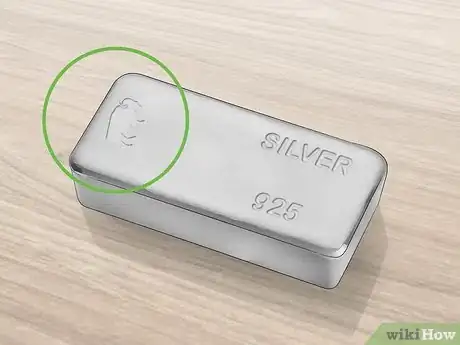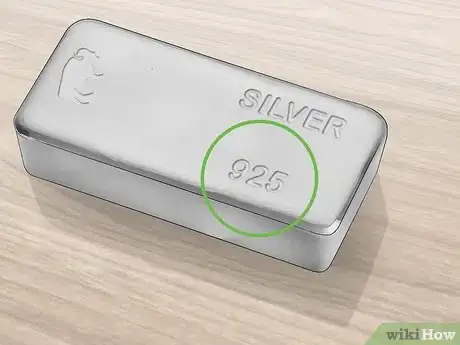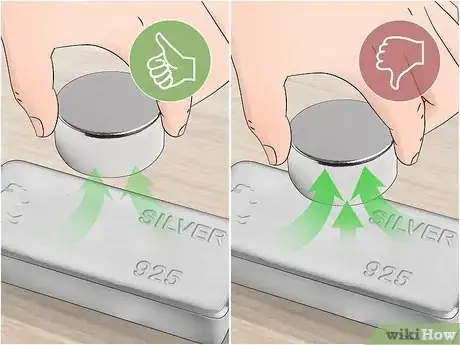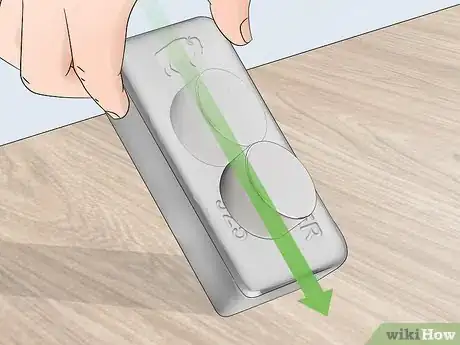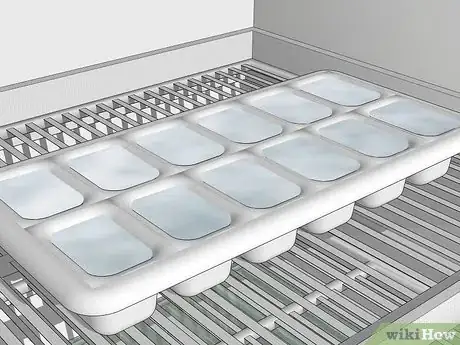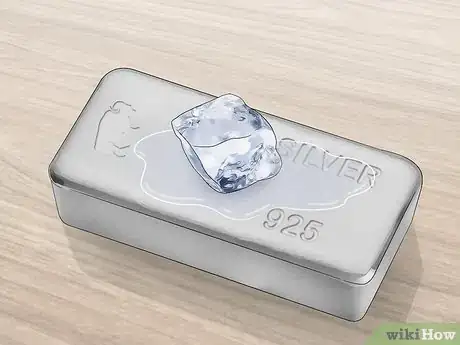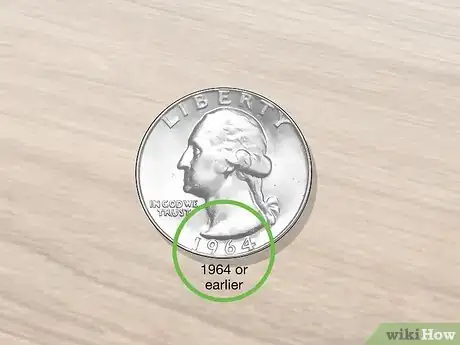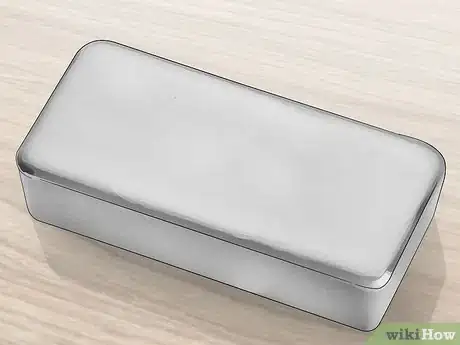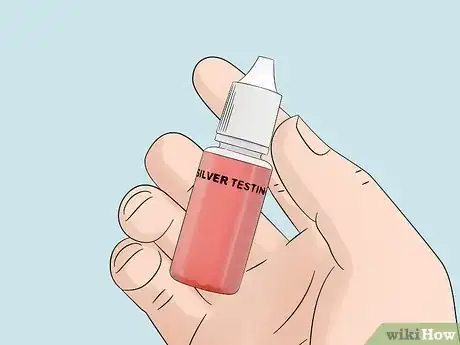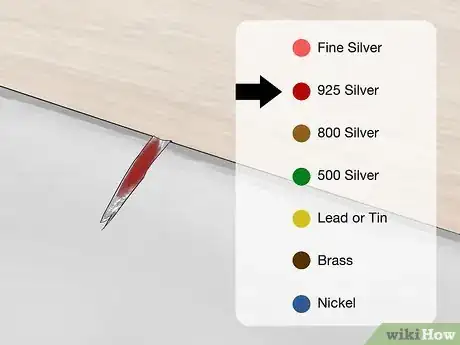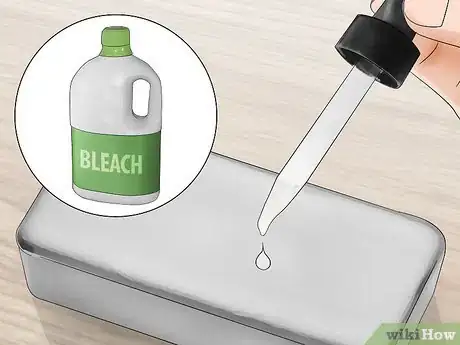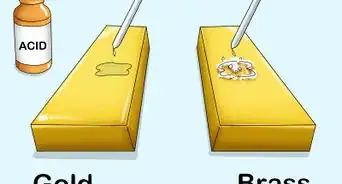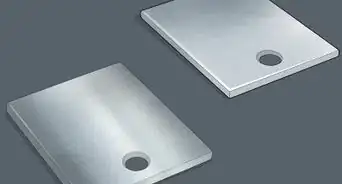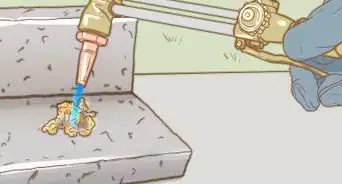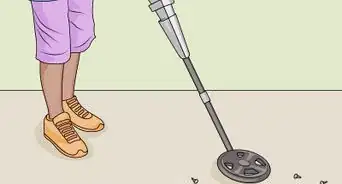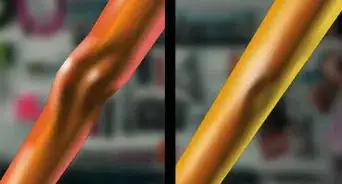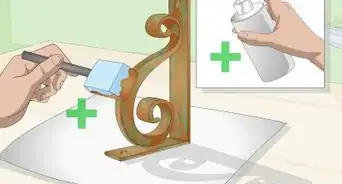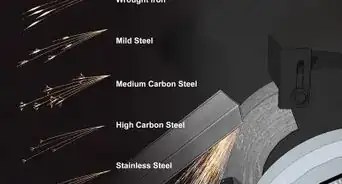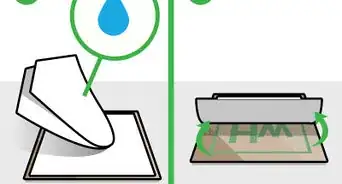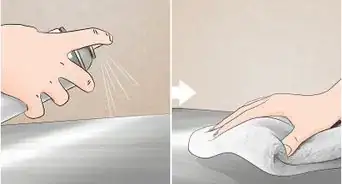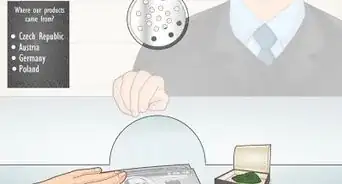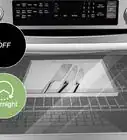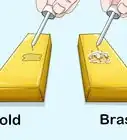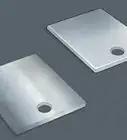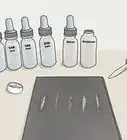This article was co-authored by Edward Lewand and by wikiHow staff writer, Amber Crain. Edward Lewand is a Graduate Gemologist & Accredited Appraiser with over 36 years of experience in the jewelry industry. He completed his residency in graduate gemology at the G.I.A. in 1979, New York and now specializes in Fine, Antique and Estate Jewelry, consultations and expert witness work. He is a Certified Appraiser of the Appraiser Association of America (AAA) and an Accredited Senior Appraiser (ASA) of the American Society of Appraisers In Gems and Jewelry.
There are 11 references cited in this article, which can be found at the bottom of the page.
wikiHow marks an article as reader-approved once it receives enough positive feedback. This article has 32 testimonials from our readers, earning it our reader-approved status.
This article has been viewed 1,646,608 times.
If you need to test a piece of silver for authenticity, you've come to the right place! Silver has distinctive properties and there are a number of easy tests you can perform at home to confirm whether your piece is real or fake. We'll also explain how to know if your piece is pure silver or silver plated. For a simple walk-through of each silver test, scroll on down!
Things You Should Know
- Use a magnifying glass to inspect the surface of the silver for stamps. If you see a 920 stamp, the piece is 92.5% silver, 900 means 90% silver, and 800 is 80% silver.
- Hold a magnet against the silver to see if it sticks. If it does, it's not real silver.
- Place an ice cube on the silver. If it melts immediately, it's not real silver.
- Apply a drop of bleach to the silver and watch for a reaction. If it tarnishes or blackens right away, it's real silver.
Steps
Authentication Stamp
-
1Look for a stamp, engraving, or marking on the surface. Items advertised as silver and sold internationally have stamps that state the silver content. If there's no stamp on your silver piece, be leery.[1]
-
2Interpret stamps like 925, 900, or 800 as the percentage of silver. Look at the silver piece with a magnifying glass. International sellers of silver will stamp silver as 925, 900, or 800. Read these numbers to figure out the percentage of fine silver in the piece.[2]
- 925 means that the piece is 92.5 percent silver (also known as sterling silver).[3]
- A stamp of 900 or 800 means the piece is 90 percent or 80 percent silver, which is often called "coin" silver.
Advertisement -
3Check for letters like "STER" and "IS" on the silver. "STER" stands for sterling, which means the silver content is 92.5%. "IS" stands for "international silver," which means the piece is made with real silver. "IS" without a number stamp could mean the silver percentage is low, or that you have a silver-plated object.[4]
- To see if the item is silver-plated or pure, try the acid test and the magnet test.
Magnet Test
-
1Place a magnet close to the silver to see if it sticks. Use a strong magnet, such as the rare-earth magnet made out of neodymium. Silver is paramagnetic and exhibits only weak magnetic effects. If your magnet sticks strongly to the piece, it has a ferromagnetic core made with a cheaper metal and isn't pure silver.[5]
- There are a few metals that don't stick to a magnet that can look like silver. Do the magnetic test in conjunction with another test to make sure the core is not another metal.
-
2Tilt a silver bar to a 45-degree angle to see if the magnet slides down slowly. Turn one of your silver bars at a 45-degree angle and slide the magnet down it. If it's real silver, the magnet should slide slowly down the face of the bar. If the silver is fake, the magnet won't move.[6]
- The magnet slides down slowly because silver is paramagnetic and the rare earth magnet induces electric eddy currents which act as an electromagnet. This creates a braking effect that slows the descent of the magnet.[7]
Ice Cube Test
-
1Grab some fresh ice for this test. Keep the ice in the freezer until you need it for the test. While it might not seem like ice and silver go together, silver has the highest thermal conductivity of any common metal or alloy (though copper is right behind).[8]
- This test works well with coins and bars, but it's tough to do on silver jewelry.
-
2Place a piece of ice on the silver and see if it melts quickly. If the silver is real, the ice will begin to melt immediately, as if it's sitting on something hot, rather than something that's just room temperature. This is because silver has very high heat conductivity.[9]
- It can help to place another ice cube on a different room-temperature surface so you can see the different in melting times.
Sound Test
-
1Perform a sound test on a silver coin. Silver makes a really lovely bell-like ringing sound when you tap on it, especially if you tap on it with another form of metal. If you want to try this out before tapping on your questionable silver, find a United States quarter made before 1965. These were made of 90% silver (US quarters made after 1965 are made of a copper-nickel alloy). The older quarter will emit a high-pitched, clear, ringing tone, while a newer quarter will just make a dull thump of a sound.[10]
-
2Drop the coin on a tabletop and listen for a high-pitched ringing sound. Hold the coin 6 in (15 cm) above a flat surface and drop it. If the coin makes a sound like a ringing bell, you have a real silver coin in your hand. If it sounds dull, the silver is most likely mixed with other metals.[11]
Acid Test
-
1Perform a chemical test analysis on the item. Use chemical analysis if there's no stamp signifying it is silver on your piece. Put on a pair of gloves first since you'll be using a corrosive acid to test the piece for purity. These sorts of acids burn skin.
- Note that this method has the potential to slightly damage your silver item. If you suspect you have a high-value item, you might be better off trying to determine the silver content using one of the other methods.
-
2Buy a silver acid test kit. You can purchase these tests online or at jewelry stores. Silver acid tests are great for pure silver, but if you think your piece is silver-plated, use a small jeweler's file to make a mark and reveal what's under the plating.[12]
-
3Find an inconspicuous place on the silver and make a small scratch. This scratch is necessary so the acid can get to the underlying metal on silver-plated items. Scratch the piece using a metal file and use a fair amount of pressure so that you can get beyond any silver plating layer.[13]
- If you don’t want to scratch your piece, use a black stone plate. These usually come with the silver testing kit, or you can buy one. Rub your silver on the surface of the black stone so it leaves a thick and relatively large deposit on the stone. Aim for a line that is 1⁄2 to 1 in (1.3 to 2.5 cm) thick.
-
4Apply a drop of acid to the scratched surface only. If the acid touches any area of the piece that isn't scratched, it will affect the polished look of the piece. If you're using a black stone, add a drop of the acid on the line you made with the stone.
- Alternatively, use a drop of vinegar (which is highly acidic) on the scratched piece. If it's real silver, the surface won't get tarnished. If the silver is fake, it will tarnish.[14]
-
5Analyze the scratched surface with the acid on it. Analyze the color that appears as the acid sinks into the piece. Be sure to follow the instructions and color scale of your specific silver testing kit. In general, the color scale is as follows:[15]
- Bright Red: Fine Silver
- Darker Red: 925 Silver
- Brown: 800 Silver
- Green: 500 Silver
- Yellow: Lead or Tin
- Dark brown: Brass
- Blue: Nickel
Bleach Test
-
1Put a drop of bleach on your silver item. Silver tarnishes extremely quickly when exposed to a powerful oxidizing agent such as common bleach.[16]
-
2Watch to see if the silver tarnishes or has no reaction. If it rapidly tarnishes and turns black, then the item is real silver. Note that silver-plated items will pass this test.[17]
- You can easily clean your tarnished silver with toothpaste, baking soda, or silver polish.
Community Q&A
-
QuestionDo you recommend a method to remove the bleach tarnish?
 wikiHow Staff EditorThis answer was written by one of our trained team of researchers who validated it for accuracy and comprehensiveness.
wikiHow Staff EditorThis answer was written by one of our trained team of researchers who validated it for accuracy and comprehensiveness.
Staff Answer wikiHow Staff EditorStaff AnswerPolish the silver with toothpaste or silver polish to remove the tarnish from the surface.
wikiHow Staff EditorStaff AnswerPolish the silver with toothpaste or silver polish to remove the tarnish from the surface. -
QuestionI have 2 oblong plates with Chinese carvings on, they are non magnetic and ice melts fast on them how can I find out what they are?
 wikiHow Staff EditorThis answer was written by one of our trained team of researchers who validated it for accuracy and comprehensiveness.
wikiHow Staff EditorThis answer was written by one of our trained team of researchers who validated it for accuracy and comprehensiveness.
Staff Answer wikiHow Staff EditorStaff AnswerIf they're non-magnetic and ice melts immediately on them, it sounds like they're silver (since those are two of the tests you can do it home). If you want to know for absolute certain, have the plates appraised by a professional.
wikiHow Staff EditorStaff AnswerIf they're non-magnetic and ice melts immediately on them, it sounds like they're silver (since those are two of the tests you can do it home). If you want to know for absolute certain, have the plates appraised by a professional. -
QuestionI have several dinner ware that might be silver. How do I sell them even I don't have a way to test them?
 wikiHow Staff EditorThis answer was written by one of our trained team of researchers who validated it for accuracy and comprehensiveness.
wikiHow Staff EditorThis answer was written by one of our trained team of researchers who validated it for accuracy and comprehensiveness.
Staff Answer wikiHow Staff EditorStaff AnswerYou probably can't sell them until you know what they're made of (since buyers will want to know that before spending their money). Try one of the simple tests in our article to check your silver!
wikiHow Staff EditorStaff AnswerYou probably can't sell them until you know what they're made of (since buyers will want to know that before spending their money). Try one of the simple tests in our article to check your silver!
Warnings
- If your skin comes into direct contact with the nitric acid, rinse the area with water for 20 minutes. Then, cover the area loosely with a bandage.[19]⧼thumbs_response⧽
References
- ↑ https://www.dawsonsauctions.co.uk/news-item/how-to-tell-if-antique-silver-is-real/
- ↑ https://www.dawsonsauctions.co.uk/news-item/how-to-tell-if-antique-silver-is-real/
- ↑ https://sites.dartmouth.edu/toxmetal/more-metals/silver-metal-of-many-faces/the-facts-on-silver/
- ↑ https://www.dawsonsauctions.co.uk/news-item/how-to-tell-if-antique-silver-is-real/
- ↑ https://terpconnect.umd.edu/~wbreslyn/magnets/is-silver-magnetic.html
- ↑ https://www.youtube.com/watch?v=NgSXg-WOEVY&t=78s
- ↑ https://www.youtube.com/watch?v=8Es3JXLZL2g&t=150s
- ↑ https://www.dawsonsauctions.co.uk/news-item/how-to-tell-if-antique-silver-is-real/
- ↑ https://www.encyclopedia.com/articles/how-to-check-silver-authenticity/
- ↑ https://www.encyclopedia.com/articles/how-to-check-silver-authenticity/
- ↑ https://www.encyclopedia.com/articles/how-to-check-silver-authenticity/
- ↑ https://www.sbcgold.com/blog/test-gold-5-simple-ways-spot-fake-gold/
- ↑ https://www.encyclopedia.com/articles/how-to-check-silver-authenticity/
- ↑ https://vintagesilver.com/how-to-test-silver-with-vinegar/
- ↑ https://www.encyclopedia.com/articles/how-to-check-silver-authenticity/
- ↑ http://www.silvercoins.com/fake-silver-coins-14-ways-to-spot-counterfeits/
- ↑ https://www.sweetandspark.com/testing-real-silver-jewelry-how-to-tell-if-your-silver-bracelet-is-genuine/
- ↑ https://www.dawsonsauctions.co.uk/news-item/how-to-tell-if-antique-silver-is-real/
- ↑ https://www.mayoclinic.org/first-aid/first-aid-chemical-burns/basics/art-20056667
About This Article
To test silver, look for a stamp with the numbers 925, 900, or 800. If you don't see a stamp, this is a red flag that the silver is fake! Next, touch a strong magnet, like a rare-earth magnet made out of neodymium, to the silver. Silver exhibits weak magnetic effects, so if the magnet sticks strongly to the piece, it's not real silver. You can also put a piece of ice on the metal. If the ice melts immediately, it's probably real silver. Buy a silver acid test if you want to confirm the material is silver. If you want to learn how to use bleach to test for silver, keep reading the article!
